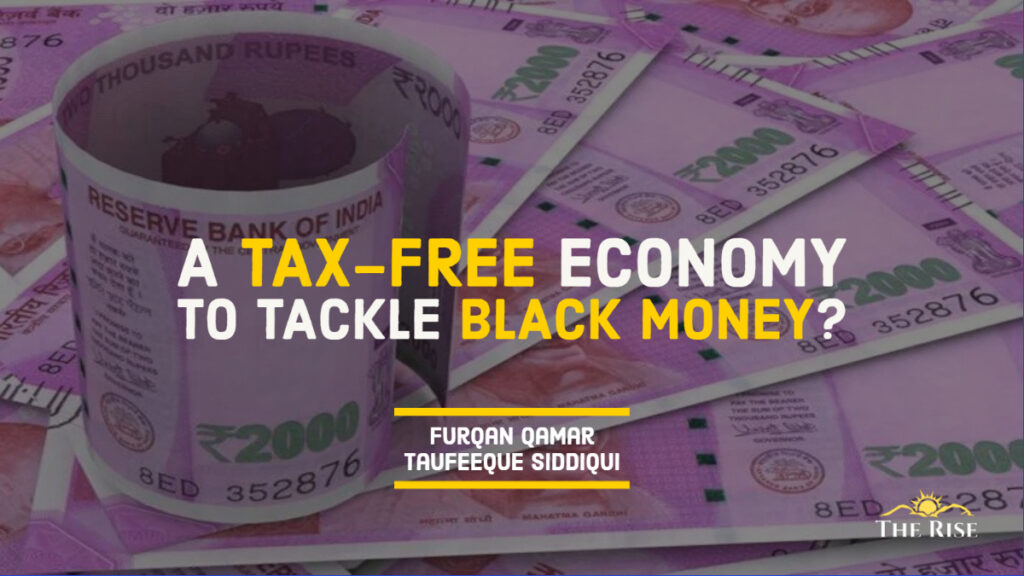Recently, Rajya Sabha MP and economist Dr. Subramanian Swamy made a bold suggestion that Income Tax be abolished to boost the economy and that the revenue loss to the public exchequer could be easily recovered through other sources. Although a good number of economists may agree that taxation is the major culprit for creating black money, they are likely to shun the idea of abolishing taxes to tackle the menace of black money, due to their orientation and training in public finance which sees taxes inevitable. Yet, a few economists should at least explore this as a possibility by factoring in all the enormities and complexities that the idea entails.
A couple of weeks ago, media was abuzz with the discovery of hidden wealth in huge amount stashed in cash, gold and property, from a pan masala perfumer and other input supplier. This treasure trove was unearthed through raids by various governmental agencies, allegedly for political reason. Political angles apart, the accused was reportedly making money by dealing in cash transaction and was hoarding and hiding his wealth to evade taxes. He was probably engaged in a kind of business where he had no need to claim input credit for GST, something which, at the time of introducing GST, was espoused to be a thing of past and as an impossibility.
Apparently, the Rs. 250 crores worth of currency notes discovered from the accused was in the form of new currency notes issued after the 2016 Demonetisation. Obviously, the ban on cash transactions in large amount following the ‘notebandi’ had not been able to serve as a deterrent. Nor did the introduction of GST, which was espoused to eliminate possibilities of tax evasion, work for this accused. Obviously, the accused had found a way around the law to generate and hoard cash, and, thus, evade goods and services tax (GST) as well as income tax. Apparently, those determined to evade taxes somehow find ways and means to do so despite the strictest laws and their enforcement.
Central Board of Direct Taxes (CBDT), Department of Revenue, Ministry of Finance, Government of India, brought out a White Paper on Black Money in May 2012. It described illegitimate money in the hands of its owners as black money. Elaborating further, it stated that the black money could include income and wealth generated either through illegitimate activities punishable under law, like crime, drug trade, terrorism, corruption etc. or by generating and accumulating by hiding it from authorities to avoid paying direct and indirect taxes and other statutory dues. The white paper goes on enumerating all the possible devises, instruments and means of creating black money in an economy hinting at the methodological issues involved in estimating its exact magnitude.
You May Like: The Economics of Clean Energy
However, citing various studies, the white paper provides estimates of black money. It cites O.P. Chopra, who estimated the black money as a percentage of Gross National Product (GNP) in India at 6.5 percent in 1960-61 and 11.4 percent in 1976-77. Quoting the estimates by the National Institute of Public Finance and Policy (NIPFP), the black money (as a percentage of GDP) was reported to be in the range of 15 to 18 percent in 1975-76; 18 to 21 percent in 1980-81; and 19 to 21 percent in 1983-84. It also refers to Suraj Gupta, who, pointing out methodological flaws in the NIPFP estimates, estimated the black money, as a percentage of GDP, to be 42 percent in 1980-81 and 51 percent in 1987-88. It quotes Arun Kumar who estimated it at 35 and 40 percent in 1990-91 and 1995-96 respectively. Referring to a World Bank Policy Paper on shadow economies all over the world during 1999-2007, the white paper mentions that the estimated shadow economy in India, as a percentage of the official GDP had increased from 20.7 percent in 1999 to 23.2 percent in 2007.
Referring to a confidential report by NIPFP, an editorial in “The Hindu” in 2015 reported the size of Parallel Economy in India at 75 percent of GDP. Alluding to the top-secret reports submitted by NIPFP, the National Council of Applied Economic Research (NCAER), and the National Institute of Financial Management (NIFM), Anjul Tomar reported in “DNA” in 2019 that the black money in India, during the period 2009-11 was about 79 percent of the GDP, of which 65 percent was created on account tax evasion.
Citing official sources, the “Financial Express” reported on 27th June 2019 that the black money in the country could vary from 7 to 120 percent of the reported GDP. ‘Arthakranti‘, a thinktank close to the government of the day, estimates the magnitude of black money in India to be as high as 2-3 times of GDP. Claiming that the legitimate economy of the country stands at 18 lakh crore and the black money being at a whopping 84 lakh crore, it recommended for the abolition of all the 56 taxes in the country.
Cloaked by nature, black money defies a precise estimate, and economists and experts have been at their wits’ end in gauging its true extent. Besides, there are also methodological divergences in measuring the black economy, which causes what economists call parallel economy, shadow economy or underground economy. Being hidden and unaccounted for, the black money does not get counted by the recorded data system. Part of it goes abroad through money laundering and part of it is hoarded in cash, gold or converted to real estate in fictitious names, thus giving rise to the shadow economy that runs parallel to the official economy.
Also Read: Introspecting Digitalization in the Indian Economy
Black Money is a menace with severe adverse implications on the mainstream economy, which gets underestimated in terms of GDP and Per Capita Income. It causes loss of revenue to the public exchequer, thus compelling it to raise tax rates for the honest and sincere tax prayers. Above all, the magnitude of the parallel economy undermines equity and causes widening of the gap between the rich and poor. Besides, it makes the monetary and fiscal policy infructuous.
Black Money is a menace with severe adverse implications on the mainstream economy, which gets underestimated in terms of GDP and Per Capita Income. It causes loss of revenue to the public exchequer, thus compelling it to raise tax rates for the honest and sincere tax prayers.
Going by the basic equation of measuring the size of the official economy, GDP = C + I + G + NX, the official GDP gets underestimated by the extent of income and wealth that the tax evaders hide from the authorities. (Where: GDP is the Gross Domestic Product; C is the private consumption; I is the private investment; G is the purchase of goods and services by the government; and NX is the export minus import or Net Import.)
Available literature suggests that an overwhelming proportion of black money is generated due to the propensity of people and institutions to evade taxes. Taxation, being at the core of the parallel economy, has seen several reforms initiatives and corrective as well as preventive measures over time, but to little avail, and the magnitude of the black money has been rising year-on-year basis.
Taxes are the key source of revenue for the governments of most countries, even though there are a few countries that are either totally tax-free or at least do not levy income and corporate taxes. But such economies are small in size and population, and have non-tax alternative sources to generate adequate revenues for the government. A tax-free economy, for a large country, is, thus, ruled out on the ground that it would deprive the government of the much-needed resources for defence, education, health, public infrastructure, social and economic welfare, utilities etc.
Also Read: The Great Indian Economy: Ravaged by COVID-19, Ruined by Petroleum Prices and Policies:
It is commonsensical that abolition of taxes may minimise, if not totally eliminate, the menace of black money and revenue losses to the exchequer may be compensated by mass printing of currency notes. Economists and experts have favoured calibration, modulation, reduction and rationalisation of tax rates to prune the propensity of people to evade taxes leading to better compliances leading to higher revenue mobilisation and even higher tax-to-GDP ratio. They have, however, shunned the idea of a tax-free economy as bizarre, impractical, and even, impossible.
A back-of-the-envelope calculation suggests that a tax-free economy is possible. Assume an economy where:
- GDP is Rs. 200 Lakh Crores, and people hide as much of their income as they report to tax authorities;
- the Tax and Non-Tax revenues are Rs. 20.00 and Rs. 1.00 Lakh Crores respectively, whereas government expenditure is Rs. 25.00 Lakh Crores;
- a law mandates that the Fiscal deficit is to be contained within 6 percent of GDP; and
- the abolition of taxes may not entail a reduction in expenditures as the human resources and infrastructure for facilitating tax collection and ensuring compliances would be used for other purposes.
Abolition of taxes would bring all the unaccounted money into the computation of official GDP; it would double to Rs. 400 Lakh Crores. Consequently, however, the fiscal deficit would shoot up from Rs. 4.00 Lakh Crores to Rs. 24.00 Lakh Crores. As a percentage of GDP, it would increase from 2.00 percent to 6.00 percent. With no tax revenues at hand, public expenditure may have to be met through non-tax revenue, borrowings or printing of currency notes. Proponents of quantity theory may regard the idea as blasphemous and would frighten us of the imminent hyperinflation, even though the Keynesians may tell us that inflation is not as much caused by money supply as it is caused by the twin factors called demand-push or supply-pull.
Augmented income in the hands of people may boost demand causing cascading effects on various segments of the economy. Freedom from the fear of violating tax rules may unleash a spree of startups and entrepreneurial activities at an unprecedented scale. Increased margins and profitability may further boost the size and scale of the economy. Besides, the abolition of taxes may be expected to unleash the drive for startups and commercial and business activities as people would no more be fearful of violating taxation rules. At the same time, with no taxation on expenditure or income, the margins and profitability too may rise, thus further enhancing the size and scale of the economy.
Also Read: Zomato Goes Public, Paytm in the Queue. Yet, 90% of Indian Startups Fail within 5 Years. Why?
The abolition of taxes may be expected to unleash the drive for startups and commercial and business activities. Augmented income in the hands of people may boost demand causing cascading effects on various segments of the economy, too.
The idea of a tax-free economy is, however, rejected as bizarre on the ground that without taxes how would governments finance defence, education, health, infrastructure, welfare, utilities etc. The fact that a few countries in the world are tax-free, does not cut ice as they are small in size, and have plentiful non-tax sources of revenue.
Besides, the quantity theory of money comes very handy to rule out any such silly move. Since MV = PQ (where M is the supply of money in the economy; V is the velocity of circulation, the number of times money is spent in a time period; P is the Price of Goods and services or average price level; and Q is the quantity of good or volume of transaction) any increase in money supply would cause inflation and, depending on the magnitude of addition to money supply, it may even cause higher inflation. It may, however, be worth reminding that the Keynesians do argue that inflation is not as much caused by money supply as it is determined by the demand-push and supply-pull factors.
Recently, though, Rajya Sabha MP and economist Subramanian Swamy made a bold suggestion that Income Tax be abolished to boost the economy and that the revenue loss to the public exchequer could be easily recovered through other sources, like the auction of spectrum licenses and natural resources like coal. A good number of economists have, however, been arguing for replacing all taxes with an expenditure tax as they think that the expenditure is easier to track and monitor than income.
In the international context, Nicolas Rabener, in his blog “Myth-busting: Money Printing Must Create Inflation” observed the money supply and inflation over a period of time in Japan, the USA and the UK, and reached the conclusion that mass money printing may upset the financial market leading to lower future return, rather than causing higher inflation.
Coming back to India, Shubhada Sabade, in a 2014 paper “Is money supply the cause of inflation? An alternative postulate to understanding inflation” demonstrated that in the Indian context inflation is not attributable to the money supply alone.
Further, if the money supply was the sole reason for inflation, the prices of goods and services must have come down when a good majority of people suffered income losses and liquidity crunch as an aftermath of demonetisation and GST.
Besides, mass printing of currency notes has been resorted to by the central banks of many large countries, albeit as an unorthodox measure, to help their economies recover from the financial crisis and adverse impact of COVID-19.
You May Like: Indian Startup Ecosystem Third Largest, Behind China & US: A Comparison of Three Growth Engines
As central banks around the world have been printing currency notes to enable their governments to offer stimulus packages, the economists and experts have come together to argue that printing trillions of dollars may not cause inflation and that it is a justified response to the COVID crisis. If printing trillions of dollars for mitigating COVID woes did not cause inflation, it could well be resorted to financing revenue losses on account of tax abolition, particularly in an economy that has high unemployment.
Although a good number of economists may agree that taxation is the major culprit for creating black money, they are likely to shun the idea of abolishing taxes to tackle the menace of black money, due to their orientation and training in public finance which sees taxes inevitable. It may be expected that a few might at least try to explore the idea in detail. After all, a reform of such magnitude has the potential of utterly altering the existing configuration of employment. Will it, therefore, be too much to ask economists to at least explore this as a possibility by factoring in all the enormities and complexities that the idea entails?
Disclaimer: The views expressed in this article are of the author solely. TheRise.co.in neither endorses nor is responsible for them.














Pingback: The Indian Economy: Stop the Slide...Before It Slips - TheRise.co.in